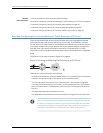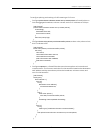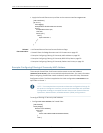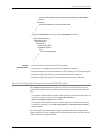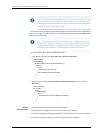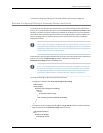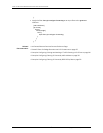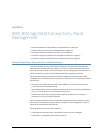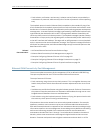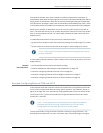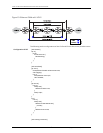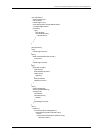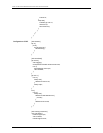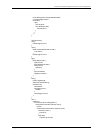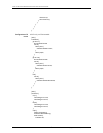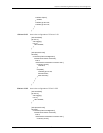
•
Fault isolation, verification, and recovery (isolation and verification are provided by a
combination of protocols, while recovery is the function of protocols such as spanning
tree)
The loopback protocol used in Ethernet OAM is modeled on the standard IP ping. After
a fault is detected, the loopback protocol performs fault verification and isolation under
thedirectionof anetworkoperator.Theloopbackis performed usingrequestandresponse
message pairs. A unicast loopback message is generated by a MEP and a loopback reply
is generated by the destination MIP or MEP. The target MAC address is learned by the
continuity checkprotocol or linktrace protocol.The loopback message's packet is always
forwarded to a unique port by the originating MEP, as determined by a MAC table lookup
or the MEP interface MAC address. The target MIP or MEP generates a unicast loopback
reply in response to the received loopback message. The loopback message follows the
same path as a data packet, and intermediate bridges simply forward the packet to the
destination MIP or MEP.
Related
Documentation
MX Series Ethernet Services Routers Solutions Page•
• Ethernet OAM Connectivity Fault Management on page 104
• Example: Configuring Ethernet CFM over VPLS on page 105
• Example: Configuring Ethernet CFM on Bridge Connections on page 112
• Example: Configuring Ethernet CFM on Physical Interfaces on page 116
Ethernet OAM Connectivity Fault Management
The most complete connectivity fault management (CFM) is defined in IEEE 802.1ag.
This topic emphasizes the use of CFM in a Metro Ethernet environment.
The major features of CFM are:
•
Fault monitoring using the continuity check protocol. This is a neighbor discovery and
health check protocol which discovers and maintains adjacencies at the VLAN or link
level.
•
Path discoveryand faultverification usingthe linktraceprotocol.SimilartoIP traceroute,
this protocol maps the path taken to a destination MAC address through one or more
bridged networks between the source and destination.
•
Fault isolation using the loopback protocol. Similar to IP ping, this protocol works with
the continuity check protocol during troubleshooting.
CFM partitions the service network into various administrative domains. For example,
operators, providers, and customers may be part of different administrative domains.
Each administrative domain is mapped into one maintenance domain providing enough
information toperformits ownmanagement, thus avoidingsecuritybreachesand making
end-to-end monitoring possible. Each maintenance domain is associated with a
maintenance domain level from 0 through 7. Level allocation is based on the network
hierarchy, where outermost domains are assigned a higher level than the innermost
domains. Customer end points have to highest maintenance domain level. In a CFM
Copyright © 2010, Juniper Networks, Inc.104
Junos 10.4 MX Series Ethernet Services Routers Solutions Guide



